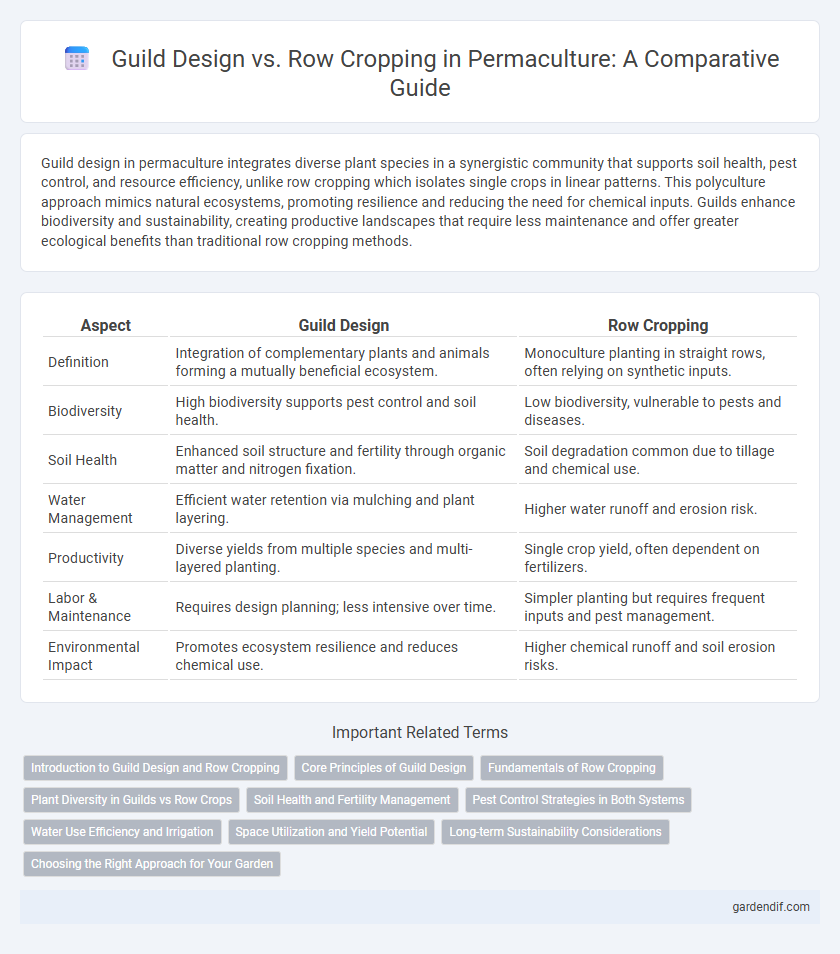
guild design vs row cropping Illustration
Guild design in permaculture integrates diverse plant species in a synergistic community that supports soil health, pest control, and resource efficiency, unlike row cropping which isolates single crops in linear patterns. This polyculture approach mimics natural ecosystems, promoting resilience and reducing the need for chemical inputs. Guilds enhance biodiversity and sustainability, creating productive landscapes that require less maintenance and offer greater ecological benefits than traditional row cropping methods.
Table of Comparison
| Aspect | Guild Design | Row Cropping |
|---|---|---|
| Definition | Integration of complementary plants and animals forming a mutually beneficial ecosystem. | Monoculture planting in straight rows, often relying on synthetic inputs. |
| Biodiversity | High biodiversity supports pest control and soil health. | Low biodiversity, vulnerable to pests and diseases. |
| Soil Health | Enhanced soil structure and fertility through organic matter and nitrogen fixation. | Soil degradation common due to tillage and chemical use. |
| Water Management | Efficient water retention via mulching and plant layering. | Higher water runoff and erosion risk. |
| Productivity | Diverse yields from multiple species and multi-layered planting. | Single crop yield, often dependent on fertilizers. |
| Labor & Maintenance | Requires design planning; less intensive over time. | Simpler planting but requires frequent inputs and pest management. |
| Environmental Impact | Promotes ecosystem resilience and reduces chemical use. | Higher chemical runoff and soil erosion risks. |
Introduction to Guild Design and Row Cropping
Guild design integrates diverse plant species in a symbiotic arrangement to promote soil health, pest control, and resource efficiency, fostering a resilient ecosystem. Row cropping involves planting single crops in linear patterns, which simplifies planting and harvesting but often leads to soil depletion and increased vulnerability to pests. Comparing these methods highlights guild design's emphasis on ecological balance versus row cropping's focus on monoculture productivity.
Core Principles of Guild Design
Permaculture guild design centers on creating synergistic plant communities that enhance biodiversity, nutrient cycling, and pest management, unlike traditional row cropping which isolates crops in monocultures. Core principles of guild design include stacking functions within the system, maximizing spatial efficiency, and fostering beneficial relationships among species to promote resilience and productivity. This holistic approach reduces external inputs while improving soil health and ecosystem stability.
Fundamentals of Row Cropping
Row cropping relies on monoculture plantings arranged in linear rows to maximize mechanized cultivation efficiency, often leading to soil erosion and nutrient depletion. This method prioritizes single-crop production with limited biodiversity, which contrasts with the polyculture approach in guild design. Understanding soil health, crop rotation, and nutrient management are fundamental to improving row cropping sustainability.
Plant Diversity in Guilds vs Row Crops
Guild design in permaculture promotes high plant diversity by integrating complementary species that support each other's growth, enhancing soil health and pest resistance. Row cropping typically involves monocultures or limited crop rotation, reducing biodiversity and increasing vulnerability to pests and soil degradation. The diverse plant interactions in guilds create resilient ecosystems that improve productivity and sustainability compared to conventional row cropping methods.
Soil Health and Fertility Management
Guild design enhances soil health by mimicking natural ecosystems, promoting biodiversity that supports nutrient cycling and microbial activity. In contrast, row cropping often depletes soil fertility due to monoculture practices and frequent tilling, which disrupt soil structure and reduce organic matter. Incorporating diverse plant species in guilds improves soil resilience, increases nutrient retention, and reduces dependency on synthetic fertilizers.
Pest Control Strategies in Both Systems
Guild design in permaculture leverages plant diversity and polyculture to create natural pest control by attracting beneficial insects and repelling harmful pests through companion planting. Row cropping typically relies on monoculture or limited crop rotation, which can increase vulnerability to pest outbreaks and often necessitates chemical intervention. Incorporating guild principles enhances ecosystem resilience and reduces the need for synthetic pesticides, promoting sustainable pest management.
Water Use Efficiency and Irrigation
Guild design enhances water use efficiency by mimicking natural ecosystems that optimize soil moisture retention and reduce evaporation through layered plant structures. Unlike row cropping, which often requires frequent irrigation due to exposed soil and monoculture practices, guild design promotes synergistic plant interactions that improve water infiltration and minimize irrigation needs. This integrated approach supports sustainable water management and reduces dependency on artificial irrigation systems in permaculture landscapes.
Space Utilization and Yield Potential
Guild design maximizes space utilization by integrating complementary plants that support each other's growth, enhancing biodiversity and reducing resource competition. Unlike row cropping, which often leaves gaps and requires monoculture maintenance, guild systems promote vertical layering and polyculture, increasing overall yield potential per square foot. This synergy optimizes nutrient cycling and pest control, resulting in more resilient and productive ecosystems.
Long-term Sustainability Considerations
Guild design enhances long-term sustainability by promoting biodiversity, improving soil health through natural nutrient cycling, and reducing pest outbreaks without synthetic chemicals. In contrast, row cropping often leads to soil degradation, increased erosion, and reliance on external inputs for maintaining crop yields. Emphasizing permaculture guilds fosters resilient ecosystems that sustain productivity and ecological balance over time.
Choosing the Right Approach for Your Garden
Choosing the right approach for your garden depends on factors such as space, plant diversity, and maintenance preferences. Guild design promotes biodiversity by integrating complementary plants that support each other's growth, improving soil health and pest resistance. In contrast, row cropping offers simplicity and ease of planting but may require more inputs and can lead to soil degradation over time.
guild design vs row cropping Infographic

 gardendif.com
gardendif.com